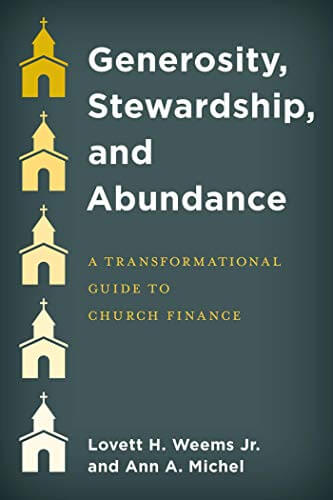Stewardship expert Joe Park says churches can promote more generous giving by better communicating the impact of their ministry, encouraging recurring electronic gifts, and challenging people to grow in generosity as part of their discipleship. He shares nine questions to help your church assess whether your giving strategy meets the mark.
An increasing number of church leaders report a slow decline in church giving—both in total dollars and in the number of people giving. Over time, this decline could have a devastating effect on a church’s capacity to fund ministry. Yet many other churches are experiencing strong growth in giving. Those experiencing sustainable growth in giving are not limited to a particular size, geography, or denomination.
You might find yourself wondering what to do differently if your giving isn’t where you hoped it would be. You could keep doing what you’ve always done. But, likely, you’ll end up experiencing more of the same.
Three keystone focal points
If you are curious about your present circumstances and open to prayerfully considering new ideas, you will need to leverage three keystone focal points to embrace God’s preferred future for your church or ministry: strategy, communications, and funding. You can’t address one without accounting for the other two. All three must work harmoniously to fulfill your God-inspired ministry potential. To this end, there are nine questions to ask yourself and your leaders.
Strategy
1. Is there a clear connection between your ministry vision and lives being changed?
Life change is the measurable evidence of ministry impact. In addition to the ability to measure success, your plans must be actionable so you can empower people to play their parts in God’s plans.
2. Are you focused on activities or outcomes?
It’s not about being busy; it’s about being effective in making disciples. Your ministry strategy requires a healthy leadership team and staff structure aligned with a commitment to focus on the evidence of lives being changed, not just the number of people who show up to an activity.
3. Are you inviting your financial leaders to share their wisdom or solve problems?
If you aren’t collaborating with your financial leaders while developing your vision and strategies, they’re missing an opportunity for personal growth and ministry impact. You’re missing their considerable wisdom, and the financial investment collaboration often inspires. Here is the catch: few great leaders or visionary entrepreneurs are interested in serving on large standing committees. Instead, invite your financial leaders to provide feedback on your plans and strategies through individual conversations or small group sessions. Ask what excites them, what is missing, what are their questions and concerns? If financial leaders and entrepreneurs are given a problem to solve, most are willing to invest their skills, wisdom, and often financial resources to identify a solution and bring it to life. Once a solution has been identified, prepare your leadership to act quickly to embrace it or give a fast no. Entangling financial leaders and entrepreneurs in red tape will lead to disappointment and disenfranchisement.
Communications
4. Have you converted your church budget into a ministry plan that will inspire others through stories?
A spreadsheet inspires few people. Your church members want to hear your budget through the lens of a story that shares the tangible difference their investment will make. The primary reason many of the most capable givers are increasing their giving to nonprofit organizations and limiting growth in their church giving is they are not hearing from their church the inspiring stories of transformation supported with clear evidence of the impact of their specific gift.
5. Do you consistently share your ministry impact stories across all relevant communication channels?
An untold story has no impact. Be careful not to project your personal communication preferences onto others. With only one in four members in church most Sundays, it is critical that stories of impact shared on Sunday are also communicated over a wide variety of communication channels.
6. Are you leveraging offering talks each week to connect giving to impact and generosity to spiritual growth?
A weekly offering talk that focuses on the transformation of one life is a built-in opportunity to champion your church’s impact and help worshipers experience the impact of their generosity on others. In most churches, it is the most powerful tool to grow giving, especially when sharing through all your communication channels with the 75% of members who were not present. The story can be of a giver’s transformation or of someone whose life was changed by the ministry’s impact of giving through the church.
Funding
7. Have you made generosity a core discipline championed in your disciple-making strategy?
The most generous churches include generosity as part of their discipleship path and core values. For example: 4G Living – Gather, Grow, Go, and Give. Or Marks of a Disciple – Prayer, Worship, Spiritual Growth, Generous Giving, and Serving Others. Don’t bury the critical discipline of spiritual growth in vague or hard-to-understand language.
8. Are you actively promoting recurring giving as the preferred method of making a gift?
As church attendance patterns shift, you can help your congregation be faithful in giving whether or not they’re present for worship. Be sure to encourage not just electronic giving options but automatic recurring gifts. Most churches can move the majority of their giving to recurring giving within 12-18 months. Ask how does passing largely empty offering plates teach new people to give? If your plates are not full then consider embracing a recurring giving campaign and stop passing them. Receptacles in the back can serve those who want to give by check or cash. Use the extra time to tell you ministry impact story.
9. Do you regularly challenge your current givers to take the next step in their generosity journey?
Encouraging people to grow as disciples includes challenging them to grow in their giving. Be specific in what you’re asking from individuals and use only the percentage of income as a unit of measure. For example, “Will you prayerfully consider increasing your giving by one or more percent of your income as you grow to a tithe (10%) and beyond?” If you don’t have a written theology of generosity, creating one is a great starting place to share what you believe the Bible teaches about giving, generosity, stewardship, percentage giving, tithing, and offerings.
Make disciples and fund ministry.
When you can positively respond to the nine questions above, you’ll have a greater degree of confidence in your ability to make a lasting impact on your church, your community, and the world.
Resolve today to do things differently. If you find the courage to try new things, your capacity to do more ministry will multiply as you become more effective at making disciples and funding ministry.
This article was adapted by the author from a blog post on Horizon Stewardship. Other free supporting resources can be found in Horizons’ Online Resource Library Giving365.
Related Resources
- 7 Practical Strategies for Nurturing a Culture of Generosity by Lovett H. Weems Jr. and Ann A. Michel
- A Simple Step-by-Step Process for Creating a Narrative Budget by Bonnie Ives Marden
- 50 Ways to Encourage Faithful Giving







